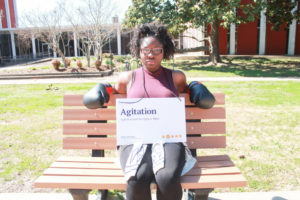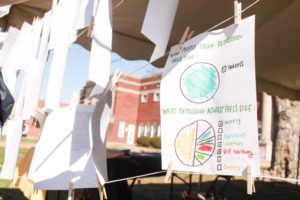By Gisselle Hernandez, Features Editor
It’s August, the beginning of your first semester in college. You’re on your own now and months pass without successfully making friends. Wintry December does not help and you’ve fallen into depression. Yet, no help is sought for fear of being judged by others for going to counseling. This is a common theme among college students, said Angie Trzepacz, director of Counseling Services. The stigma surrounding mental health issues is something the Bateman team at Murray State hoped to demolish on March 8 when they hosted their “Racers Call Your Bluff” event in front of Carr Health.
The Bateman team is a subdivision of the Public Relations Student Society of America in the Journalism and Mass Communications Department. Bateman is a national competition, and they give each team in the U.S. an issue or ‘client.’ This year, the aim was to change the stigma surrounding mental health, and although the Murray State team has been preparing since last August, they had from Feb. 15 to March 15 to implement their campaign.
According to the team’s informational posters in every bathroom on campus, nearly one in every five people have a diagnosed mental health condition. The poster, entitled “Emotional Pain ‘Stinks,’” said there are five stages to emotional suffering: Personality Change, Agitation, Withdrawal, Poor Self-care and Hopelessness. A student ‘portrayed’ the signs at the event by holding up different mask cutouts that signified the symptoms. The event also had a piñata, with the word ‘stigma’ splayed across it, so students could literally beat the stigma. Qdoba was also giving away free queso and samples, while Counseling Services offered brochures on information about mental health. They also had bubbles, stress-relief balls and time turners, all to sooth people if they needed to take a moment to breathe, said Trespass.
Heather Mix, senior from Ballard County, Kentucky, is the president of the Murray State Bateman team. She said they chose Murray State because it hits home for them and they wanted to help the community so every student can feel comfortable getting the help they deserve. Students who approached the tent were encouraged to go online to www.racerscallyourbluff.com to read the signs and sign the mental health pledge.
Alaina Stewart from Houlton, Maine, and a member of the Bateman team, said the most difficult part was the actual execution of the event.
“We came up with all these great ideas, but have a really small budget and a limited number of donations,” she said.
Mix said people have been good about donating and even though the budget was $300 – obtained from PRSSA – they have not used all of it. Mix said Murray State has been in the top three before in Bateman history and hopes they once again reach the top three this year.
“If we win, we’re going to get to go to nationals in Orlando,” she said. “If we win first place, PRSSA and the department gets $3,500 dollars. So on top of doing something great, we are also raising money for the department.”
The team has spent months planning and as for the bathroom posters, Mix said if they did a normal billboard, people weren’t going to pay attention to them.
“If you’re in the bathroom you need some kind of reading material,” she said. “I know it’s weird but if it’s right there, eye level with perfect graphics and good information, you’re bound to read them.”
There was also a story wall at the Bateman tent that showcased people’s battles with mental illness. The stories were completely anonymous and people submitted stories in advance online. Students could also add to the wall since the team had papers and markers to use to write their story.
“The stories kind of ask students to talk about some mental overcomings [sic] they’ve had to do throughout their lives and to let everybody know they’re not the only one,” Mix said. “You are not alone; no Racer stands alone.”
The idea came from Jessica Foster, senior from Murray, Kentucky and a member of Bateman. She said she thought of it when she remembered seeing something similar in New York City last summer. She said someone was collecting handwritten stories and she was running late to work when she stopped to read them.
“I spent an hour reading these stories; I was in tears in front of everyone,” she said. “People were hugging people and I think it just shared everyone’s experiences. There were really sad stories and really positive experiences. We all have to overcome something, so being able to share that is kind of why it meant so much to me.”
Trzepacz said a lot of people don’t realize how significant the mental health issues are for students this age, and that they can still go to college if they have mental health issues. She said there are a lot of services available to help them through the stress surrounding school and other things.
“There are definitely some who don’t want to ask for help or don’t think counselors can help or they’re just embarrassed because somebody might see them there or might judge them for it,” she said. “But I don’t think the stigma is nearly as bad as it used to be.”
Trzepacz thinks there are people that are a lot more willing to come to counseling and to tell their friends, “I go to counseling and it helps me you should go, too.” She has been the director for Counseling Services for five years and said they get more and more students every year. However,Trzepacz said mental health it is worse in the fall.
“I think that the weather has a lot to do with it and a lot of people, even if they don’t actually have seasonal affective disorder, they’re still affected by the weather,” she said. “But also in the spring a lot of people are looking forward toward the end of the year and so they feel like, ‘Oh, I’m stressed but I can see the light at the end of the tunnel. I can make it till then.’”
Photos by Jenny Rohl/The News

